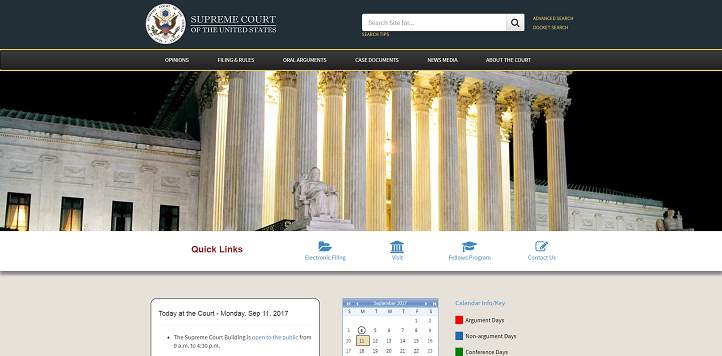Supreme Court Begins New Term with Updated Website With E-Filing

While the justices were on summer break, the U.S. Supreme Court’s website got a much-needed update. Even more significant, the Court announced that e-filing will become mandatory in November.
The Supreme Court is notorious for its slow adoption of technology. Several justices still don’t use email, but continue to exchange written correspondence. While many state and federal courts have relaxed their rules about cameras in the courtroom, the Supreme Court has resisted calls to allow its proceedings to be recorded. In defense of the continued photography ban, the justices have cited concerns regarding how it may impact the proceedings and how the media may use the footage.
“While courts routinely consider evidence and issue decisions concerning the latest technological advances, they have proceeded cautiously when it comes to adopting new technologies in certain aspects of their own operations,” Justice Roberts stated when first announcing plans for the e-filing system in 2015.
The Supreme Court unveiled its new website on July 28, 2017. In addition to updated graphics and a cleaner design, the website allows the public to more easily access the Court’s opinions and other case documents. It also provides a brief snapshot of the day’s events at the Court. Of course, the most-anticipated update is the new electronic filing “button.”
The Court’s new system will allow the public to access documents filed with the Court, such as petitions, responses to petitions and merit briefs, for free on its website. “A quick link on the Court’s website homepage will provide access to the new system, developed in-house to provide prompt and easy access to case documents. Once the system is in place, virtually all new filings will be accessible without cost to the public and legal community,” the Court said in a press statement.
To start, the official filing of documents will continue to be on paper in all cases, but parties who are represented by counsel will also be required to submit electronic versions of documents through the electronic filing system. The filings will then be posted to the Court’s docket and made available to the public through the Court’s website. Filings from parties appearing pro se will not be submitted through the electronic filing system, but will be scanned by Court personnel and made available for public access on the electronic docket.
Previous Articles
SCOTUS Wraps Up Oral Arguments for the Term
by DONALD SCARINCI on May 17, 2022
The U.S. Supreme Court has concluded its oral arguments for the October 2021 Term. The justices hea...
SCOTUS Rules Censure of Elected Board Member Didn’t Violate First Amendment
by DONALD SCARINCI on May 10, 2022
In Houston Community College System v. Wilson, 595 U.S. ____ (2022), the U.S. Supreme Court held th...
Supreme Court Breach Is Not the First Involving Roe v. Wade
by DONALD SCARINCI on
The recent disclosure of Justice Samuel Alito’s decision purporting to overturn Roe v. Wade is ar...
The Amendments
-
Amendment1
- Establishment ClauseFree Exercise Clause
- Freedom of Speech
- Freedoms of Press
- Freedom of Assembly, and Petitition
-
Amendment2
- The Right to Bear Arms
-
Amendment4
- Unreasonable Searches and Seizures
-
Amendment5
- Due Process
- Eminent Domain
- Rights of Criminal Defendants
Preamble to the Bill of Rights
Congress of the United States begun and held at the City of New-York, on Wednesday the fourth of March, one thousand seven hundred and eighty nine.
THE Conventions of a number of the States, having at the time of their adopting the Constitution, expressed a desire, in order to prevent misconstruction or abuse of its powers, that further declaratory and restrictive clauses should be added: And as extending the ground of public confidence in the Government, will best ensure the beneficent ends of its institution.




